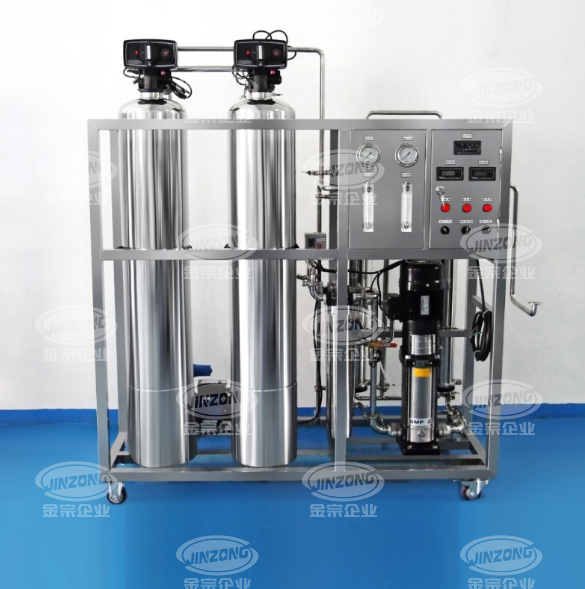In industrial production, high-quality water sources are crucial for ensuring product quality, protecting equipment lifespan, and meeting environmental requirements. RO water treatment equipment, as an efficient and reliable purification method, is widely used in many industries such as chemical, electronic, pharmaceutical, food and beverage, etc. However, the selection of industrial RO water treatment equipment is not an easy task and requires comprehensive consideration of multiple factors to ensure its performance, efficiency, and economic benefits. Jinzong Enterprise, with over 20 years of experience in the production, design, and development of water treatment equipment, will provide a detailed guide for the selection of industrial RO water treatment equipment.

1、 Clarify Water Quality Requirements and Treatment Objectives
The primary task of purchasing industrial RO water treatment equipment is to accurately grasp the water quality requirements and treatment goals. This includes:
Raw Water Quality Analysis: Conduct a comprehensive inspection of the incoming water source to understand its chemical composition, ion concentration, turbidity, microbial content, and other parameters, ensuring that the equipment design can effectively remove specific pollutants.
Water Quality Standards for Effluent: Clarify the specific requirements of each production process for water quality, such as conductivity, hardness, total organic carbon (TOC), microbial indicators, etc., to ensure that the effluent quality of RO equipment can meet or exceed these standards.
Processing Capacity Demand: Based on production scale and water usage patterns, calculate the daily or hourly processing capacity of the required equipment to ensure that the water production capacity of the equipment matches the actual demand.
2、 Evaluate Equipment Performance and Technical Parameters
RO Membrane Components: Membrane components are the core components of RO equipment, and their performance directly affects the water purification effect. Attention should be paid to factors such as desalination rate, flux, chemical stability, and anti pollution ability of the membrane, and suitable materials (such as polyamide composite membrane, cellulose acetate membrane, etc.) and membrane models should be selected based on water quality characteristics.
Recovery Rate and Energy Consumption: Water conservation and energy conservation are important considerations in industrial production. Choosing equipment with high recovery rates can reduce concentrated water emissions and lower operating costs; Meanwhile, pay attention to the energy consumption indicators of the equipment, such as the energy consumption per ton of water (kWh/m) ³), Choose devices with high energy efficiency ratios.
Pretreatment and Post-treatment System: Based on the raw water quality, evaluate whether it is necessary to configure pre treatment (such as multimedia filtration, activated carbon adsorption, softening, ultrafiltration, etc.) and post-treatment (such as UV disinfection, EDI electrodeionization, etc.) systems to ensure the stable operation of the RO membrane and meet the effluent water quality standards.
3、 Inspect Equipment Manufacturers and After-sales Service
Manufacturer Qualification and Experience: Choose equipment manufacturers with relevant industry qualifications, rich project experience, and good market reputation to ensure the professionalism and reliability of equipment design, manufacturing, installation, commissioning, and other aspects.
Customized Services: Industrial water demand often has special characteristics, and excellent equipment suppliers should have the ability to provide personalized solutions, such as process optimization for complex water quality and non-standard design for specific spatial layouts.
After sales Service System: Assess the after-sales service network, response speed, repair capability, spare parts supply, etc. of equipment suppliers to ensure timely and effective technical support and maintenance in case of equipment failure during operation.
4、 Economic and Investment Return Analysis
Equipment Procurement Cost: Compare quotes from different brands and models of equipment, comprehensively consider factors such as performance, quality, and service life, and conduct a cost-effectiveness analysis.
Operating Costs: Calculate the energy consumption, medication consumption, maintenance, and material replacement costs during equipment operation, and evaluate long-term operating costs.
Investment Return Period: Calculate the investment return period based on the combination of equipment purchase cost and operating cost, as well as potential benefits such as increased production efficiency, extended equipment life, and reduced environmental penalties due to water quality improvement, to ensure the economic benefits of the project.
In summary, the selection of industrial RO water treatment equipment needs to be comprehensively considered from multiple dimensions such as water quality requirements, equipment performance, manufacturer strength, and economy. Through rigorous analysis and comparison, ideal equipment that can meet production needs and maximize economic benefits can be selected.
|
联系我们
全国服务热线 肇庆一分厂:广东省肇庆高新区(大旺)康泰街3号 肇庆二分厂:广东省肇庆高新区(大旺)建设路36号 E-mail: jinzong@jinzong.com.cn
|


